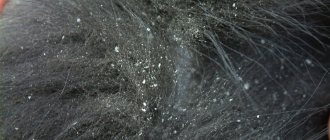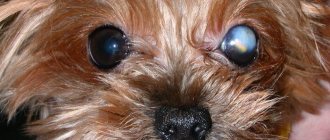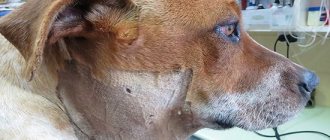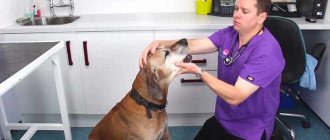Dog acne is one of the common skin diseases that is typical for man's four-legged friends. However, the reasons for the appearance of this disease are somewhat different from those inherent in people. Pimples on a pet's skin can occur due to hormonal imbalances, allergies or infections. The article will describe in detail what types of rashes there are, what symptoms are characteristic of this or that type of acne, and what treatment the animal will need.
What types of acne do dogs get?
A rash on the body of a four-legged friend is a very common phenomenon, which, from a physiological point of view, is expressed in the form of the appearance on the surface of the skin of areas with a changed structure and color.
There are several types of acne:
- urtica (blister) - protrusion of the skin due to swelling of the dermis;
- macula (spot) - micro areas of a different skin color, resulting from hemorrhage;
- bulla (bubble) - a protrusion of skin with a cavity, reaching a size of more than 5 mm;
- nodus (node) - a neoplasm in the upper layer of the dermis that does not have a cavity, which can reach the size of a chicken egg;
- papule (nodule) - protrusion of the skin due to inflammation, without the formation of a cavity;
- pustule (abscess) - protrusion of the skin due to inflammation with the appearance of a cavity filled with pus.
Often, the localization of acne in dogs is the muzzle, sometimes the area of the base of the tail, anus, belly, groin, less often - the entire torso, ears.
Diagnostics
It is impossible to determine the nature of the disease by the appearance of the rash, therefore, to obtain the correct, complete treatment, a diagnosis from a veterinarian is necessary. He will conduct an examination and take samples that will indicate the causative agent of the disease. The prescribed treatment will be specialized and comprehensive, which means it will help to quickly cope with the problem and avoid the development of complications.
Why do dogs get acne?
The underlying causes of rashes in pets are not known. From a physiological point of view, a pimple is an inflammation in the sebaceous-follicular apparatus, in which the stomata of the sebaceous glands become clogged, inflammation begins directly, and, in the case of secondary infection, suppuration appears.
The causes of rashes in pets can be several factors:
- hormonal disorders;
- polygenic inheritance;
- injuries received;
- ultraviolet radiation;
- stressful situations.
Find out the symptoms and treatment of fungus in dogs.
Pimples that appear can be accompanied not only by inflammation and suppuration, but also by itching and pain. Externally and symptomatically, acne can be similar to other skin diseases, so timely diagnosis of the problem by a specialist is of great importance.
Allergy
There can be several causes of allergies in a dog:
- nutrition (food allergies);
- presence of fleas;
- environmental irritants.
Typically, symptoms of allergies are skin rashes, itching, red skin, and swelling. Acne is localized in the armpits, face, ears, paws, stomach, and back. It will not be possible to diagnose the disease without the help of a veterinarian; for this purpose, it is necessary to conduct certain studies to identify the real cause of the phenomenon and determine methods for eliminating it.
After making a diagnosis, the veterinarian will prescribe the medications necessary for treatment and tell the pet owner how to behave correctly in the current situation. Not all types of allergies can be cured forever, but with the right approach and appropriate preventive measures, the likelihood of the problem reoccurring can be minimized:
- food allergy - exclude the product to which the reaction occurs;
- allergy to fleas - use special collars, hygiene products, etc.;
- reaction to external stimuli - exclude contact with them.
Allergy is a rather serious disease, so delaying the solution of the problem or self-medicating is strictly prohibited.
Demodectic mange and sarcoptic mange
The causative agents of these diseases are ticks, but their course and symptoms vary.
Demadecosis most often appears in young dogs. The cause of its occurrence is a mite living inside the hair follicles. The parasite is often transmitted to the puppy from the mother at birth, but in small quantities it does not pose a danger. The tick becomes active and causes harm to the animal when the dog’s immune system begins to work poorly.
The appearance of severe itching, hair loss, scabs and wounds, lethargy of the animal while maintaining a good appetite most likely indicate the occurrence of demodicosis. Since the disease is not infectious, but is associated with a weakened immune system, there is no need to isolate the animal.
Sarcoptic mange is caused by a mite that lays eggs in the dog's skin, which provokes inflammatory processes. Severe itching, baldness in the armpits, chest, abdomen, groin area, and the appearance of crusts on the skin are symptoms of sarcoptic mange infection. The danger of the disease is that by scratching the skin, the animal can provoke the appearance of ulcers and additional infections.
Parasitic diseases
Parasites are the constant leaders among the causative agents of canine diseases, and the most common of them are fleas and lice eaters. Hiding in the fur of dogs, they feed on blood or epidermal scales. By scratching the bite sites, the pet injures the skin and can become infected, which creates the preconditions for the development of infectious dermatitis. Therefore, if you walk your pet on the street, take it to events and nature, it is important to take care of protection - timely treatment with drops (Bars Forte) or wearing an anti-parasitic collar (Bars).
But fleas and lice are not the only parasites. The cause of itching, inflammation and anxiety of the animal can be microscopic mites that cause:
- demodicosis
is a disease caused by a mite that lives inside the sebaceous glands and hair follicles. The main symptoms of the disease are hair loss on the face and neck, and the formation of dense convex nodules on the skin. There is almost no itching with demodicosis. Demodectic mange is difficult to treat - powerful general antiparasitic drugs and careful care of damaged skin areas are required; - Sarcoptic mange
is a dangerous disease caused by microscopic mites living in the thickness of the skin. They can damage nerve endings and cause unbearable itching. The hair quickly falls out, the skin becomes covered with abrasions and pustules, and sometimes the dog scratches until it bleeds. If you do not consult a doctor, your pet may die from anemia and exhaustion; - Otodectosis
is a disease caused by ear mites. Typical manifestations are itching and scratching in the ear area, the presence of dense brown crusts inside the auricle. Treatment is with antiparasitic ear drops.
There are still many scabies mites. Some of them can cause disease in humans. Fortunately, they are not capable of reproducing in human skin. But it is necessary to take precautions when treating a scabious dog, otherwise the owner can provide himself with a month of extremely unpleasant sensations. We also remind you that canine scabies medications should not be used on humans.
In relation to various stages of development of sarcoptic and demodectic mites (larval and mature), the acaricidal solution “Amit Forte”, drops on the withers “Dironet spot-on”, and spray “Bars Forte” have pronounced properties. The use of drugs is carried out under the supervision of a veterinarian.
Causes of acne in puppies
Puppies in their first year of life require special care and respect. Due to the immature immune system, the puppy’s body is poorly protected from the effects of numerous pathogenic microorganisms, which may not be dangerous for adult dogs.
Acne in puppies in the first year of life is a common, albeit rather unpleasant phenomenon, which may be evidence of:
- food allergies;
- improper care;
- development of the disease.
In any case, if acne appears on the puppy’s skin, the pet must be shown to a veterinarian. The specialist will conduct an examination and give recommendations for care, adjust nutrition or treat the animal if necessary.
Medicines you should have in your veterinary medicine cabinet
- "Migstim" is a solution with antiseptic and anti-inflammatory properties. Indispensable for treating wounds and abrasions.
- Okvet medicinal shampoo with chlorhexidine - reduces the duration of treatment of skin diseases, helps remove inflammatory products, microorganisms and allergens from the skin and fur of the animal, and also eliminates the cause of the unpleasant odor..
- Elite Professional spray shampoo will help prevent fungal infections of the beard of wire-haired dogs.
Read the instructions before using medications.
What breeds are predisposed to acne?
Owners of pets of smooth-haired breeds (boxers, bulldogs, rottweilers), as well as those whose skin has a large number of folds (shar peis, pugs) need to be especially careful. Their pets are at risk and more often than dogs of other breeds suffer from the appearance of acne on the skin.
We advise you to learn how to treat heart failure in dogs.
It is not known exactly what causes this problem. It is assumed that rashes in dogs of these particular breeds may be the result of a genetic predisposition or a greater degree of damage to the external integument.
Symptoms of the lesion
Regardless of what caused the disease, all symptoms have common features:
- Changes in the color and condition of the skin, hyperemia, swelling, inflammation, peeling, formation of crusts, leakage of ichor when cracking or scratching the surface, purulent discharge when a bacterial infection occurs.
- Thinning, thinning or complete loss of fur.
- Severe itching and pain. The dog constantly scratches the sore spot, may even try to bite, does not allow anyone to approach him, examine or treat the damage, becomes aggressive or apathetic, lethargic.
- With large affected areas, the animal becomes especially susceptible to other diseases.
Don't expect everything to go away on its own. The disease will progress.
How is the disease diagnosed?
Establishing a correct diagnosis will require the veterinarian to carry out a set of measures:
- external examination of the dog (the breed and age of the animal are taken into account);
- cultures to determine pathogenic microbes.
Based on the clinical picture, the medical history obtained and by excluding other diagnoses, a qualified specialist determines the real cause of the rash on the dog’s body and methods of its treatment.
Possible complications
Harmful bacteria that cause skin rashes and untimely contact with specialists can significantly worsen a dog’s health. In addition, some diseases can be dangerous to humans.
Without proper treatment, a harmless rash can turn into a purulent wound, which over time can destroy not only soft tissue, but also bones. There is always a risk of blood poisoning, the development of sepsis and encephalitis, which can lead to the death of the animal in terrible agony.
Delayed treatment can result in serious consequences for the animal.
Chronic diseases can often result from neglect of acne. This means that the dog will have to live on maintenance therapy all the time.
Treatment of acne in dogs
Treating acne in dogs without first consulting a veterinarian is incorrect behavior of the owner, which can aggravate the pet’s situation and even lead to the development of a chronic form of the disease, requiring lifelong treatment for the animal.
As prescribed by a specialist, it is necessary to treat the affected areas of the dog’s skin with special ointments, give the pet pills, and in some cases, additional medications necessary to normalize hormonal levels. If such therapy does not produce a positive result, the doctor prescribes antibiotics and drugs to restore the dog’s intestinal microflora.
Read the symptoms, diagnosis and treatment of flea dermatitis in dogs.
Every pet owner should understand that starting to treat acne in the early stages is much easier than with advanced forms of the disease, but in any case this is a rather lengthy process.
What can the owner do?
- Adjust the dog's diet
. The development of dermatitis is promoted by deficiencies of vitamins A, B and unsaturated fatty acids. To compensate for their lack in feed, the veterinarian may prescribe vitamin-mineral complexes and other feed additives. For dogs suffering from skin diseases, the AVZ company offers the mineral and vitamin feed additive “Bone with Brewer’s Yeast.” - Follow proper care for your pet.
First, you need to avoid rubbing the skin with the collar and muzzle, if any. In addition, skin dermatitis tends to be complicated by a bacterial infection, so the affected areas can be treated with antiseptics, but only as prescribed by a doctor. For these purposes, the AVZ company offers a solution “Migstim” based on the antimicrobial drug miramistin, supplemented with chamomile extract, which has an anti-inflammatory effect, chitosan succinate and ethyl alcohol. - Follow treatment tactics.
External agents in the form of ointments, gels and sprays should be applied as prescribed by the doctor, do not interrupt the course and do not skip treatments. For complications of dermatitis with a microbial infection, the veterinarian may prescribe oral antibacterial drugs, and for fungal infections, antifungal drugs. These medications may have side effects such as nausea and decreased appetite. But the treatment must be continued, just consult a doctor to adjust the prescriptions. As a rule, the inclusion of antioxidants and hepatoprotectors in the course can reduce unpleasant symptoms.
To prevent skin diseases of bacterial etiology, Okvet medicinal zoo shampoo with chlorhexide can be prescribed.
How to help a dog at home
In addition to drug treatment for a dog prescribed by a veterinarian when acne is detected, the pet’s health can be significantly improved through special home care. An effective way to treat acne in dogs is with special bath products containing benzoyl peroxide. Compresses made from calendula solution are a great help in solving the problem of rashes, but before starting the procedure, you need to make sure that the animal does not have an allergic reaction.
To do this, apply a small amount of calendula tincture to the skin and monitor the reaction - normally there should be no redness or itching. You can’t use brilliant green and iodine to treat acne - they can lead to additional trauma to the skin, but they definitely won’t help solve the existing problem.
Prevention and dietary recommendations
Keep an eye on your dog and avoid contact with sick animals. Eliminate allergens if a rash appears on your stomach. Treat your dog regularly for fleas and ticks. To avoid ringworm, scabies and other fungal skin infections, get vaccinated. Strengthen your dog's immunity.
Many skin diseases in dogs are caused by poor nutrition, so pay special attention to the diet. Consider these factors:
- Do not give food from the table, especially peppered, fried, fatty foods.
- If you prefer artificial food, buy only a high-quality product.
- During feeding, monitor your pet's reaction. Discharge from the eyes and hives are a reason to reconsider your diet.
- Add omega-3 fatty acids to your food. They reduce skin inflammation in chronic skin diseases in dogs.
During treatment, do not forget to give your dog vitamins and minerals that affect skin health:
- Vitamin A – deficiency leads to peeling.
- Vitamin E, selenium - neutralize the effect of free radicals, prevents the destruction of connective tissue.
- B2 – deficiency causes cracks.
- B7 – deficiency leads to baldness.
- Zinc – is involved in the synthesis of collagen, which helps maintain skin elasticity. It also prevents drying and peeling of the skin.
- Copper deficiency causes incomplete keratinization, which leads to excessive dryness.











